The Essentials
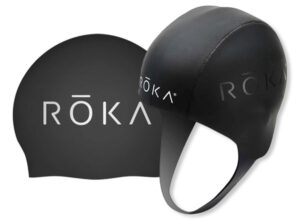 Swim Cap – While you don’t need this item while you’re training, you’re going to need it for race day, so you might as well get used to wearing one while you train. I would recommend a silicone swim cap. You can get a ROKA swim cap for about $10. If you’re going to venture into super cold water, a Thermal Neoprene swim hood with strap may be in your future. I have never used one but probably should have for my 2015 Lake Tahoe Ironman. Talk about brain freeze! Though I will say the lake was much warmer than the 32 F air temperature on race day.
Swim Cap – While you don’t need this item while you’re training, you’re going to need it for race day, so you might as well get used to wearing one while you train. I would recommend a silicone swim cap. You can get a ROKA swim cap for about $10. If you’re going to venture into super cold water, a Thermal Neoprene swim hood with strap may be in your future. I have never used one but probably should have for my 2015 Lake Tahoe Ironman. Talk about brain freeze! Though I will say the lake was much warmer than the 32 F air temperature on race day.
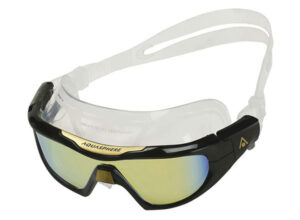 Goggles – For sure you’re going to need a decent pair of goggles. There are many designs available, and I recommend trying a few pair to make sure you have the right fit for your face. I personally like the larger goggles, such as the Vista Pros by AquaSphere. They just fit my face better. The more traditional, smaller goggles do not give me a comfortable fit and often will leak water. Another available option I’ve seen recently is by TheMagic5. They will create a custom-fit pair of swim goggles for you by measuring the contours of your face. Another thing to consider would be lens color (dark vs clear). I prefer the darker lenses as I typically swim outside in the California sun. Lastly a pair of goggles may feel good to you in the pool but not in the open water, so ensure you take both environments into account.
Goggles – For sure you’re going to need a decent pair of goggles. There are many designs available, and I recommend trying a few pair to make sure you have the right fit for your face. I personally like the larger goggles, such as the Vista Pros by AquaSphere. They just fit my face better. The more traditional, smaller goggles do not give me a comfortable fit and often will leak water. Another available option I’ve seen recently is by TheMagic5. They will create a custom-fit pair of swim goggles for you by measuring the contours of your face. Another thing to consider would be lens color (dark vs clear). I prefer the darker lenses as I typically swim outside in the California sun. Lastly a pair of goggles may feel good to you in the pool but not in the open water, so ensure you take both environments into account.
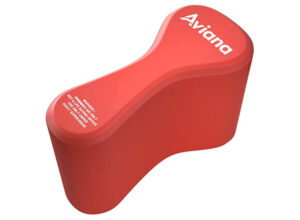 Pull Buoy – This piece of equipment aids in buoyancy. It helps support the swimmer’s body in a horizontal (proper) position and also helps isolate the arms and upper body for a workout focused on developing upper body strength and technique. You will feel faster when using a pull buoy, but don’t get too used to it since you can’t use it in a race. Often you will see coaches recommend an ankle strap as well to keep the feet close together, helping with a strong core.
Pull Buoy – This piece of equipment aids in buoyancy. It helps support the swimmer’s body in a horizontal (proper) position and also helps isolate the arms and upper body for a workout focused on developing upper body strength and technique. You will feel faster when using a pull buoy, but don’t get too used to it since you can’t use it in a race. Often you will see coaches recommend an ankle strap as well to keep the feet close together, helping with a strong core.
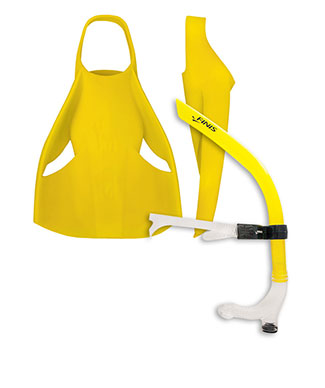 Fins – Traditionally fins are helpful during training because they increase the efficiency and power of your kick while swimming. They can help with ankle flexibility as well. In addition to making your kick stronger, beginners can benefit from the use of fins during drills. I remember that while I was first going through the technique drills, they would keep me from sinking. The type of fins you buy depends on your individual needs and preferences. Generally, swim fins designed for triathlon training are shorter and more flexible than fins designed for recreational swimming. Look for fins with comfortable foot pockets that fit securely on your feet and a fin blade that won’t slip off when you kick.
Fins – Traditionally fins are helpful during training because they increase the efficiency and power of your kick while swimming. They can help with ankle flexibility as well. In addition to making your kick stronger, beginners can benefit from the use of fins during drills. I remember that while I was first going through the technique drills, they would keep me from sinking. The type of fins you buy depends on your individual needs and preferences. Generally, swim fins designed for triathlon training are shorter and more flexible than fins designed for recreational swimming. Look for fins with comfortable foot pockets that fit securely on your feet and a fin blade that won’t slip off when you kick.
Snorkel – Swimming is all about technique, and if you are just starting out or are even an intermediate, there are many things to remember all at once and it can get overwhelming. A snorkel is good for swim training because it allows you to focus on technique and proper body position while swimming without having to turn your head to breathe. It becomes one less thing to remember. You can concentrate on the most important aspects of the stroke, such as body position, arm motion, and kick technique, without having to worry about turning your head to take a breath.
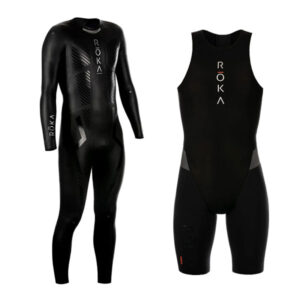 Wetsuit – I debated if I should put this item in the essentials or nice-to-have list. After some thought I decided it belonged in the essentials because there are many events (at least here in NA) that are wetsuit legal. If wetsuits are legal, you’re going to want one. They can keep you warm in the colder water temperatures and usually makes you a bit faster, as they add buoyancy and make you feel more comfortable in the water if you’re a beginner. Having said that, it does take some getting used to if you never wore one before, which is why I recommend to my athletes to purchase one early in their training so they can use it a few times to get the feel for it. The type of wetsuit you should invest in depends on the swim portion of your event. The typical wetsuit is a full-sleeve suit with good neoprene material, which will provide the most warmth and buoyancy. If the water is a bit warmer, you may choose a sleeveless wetsuit or even a swimskin. I do prefer the sleeveless as it provides much better range of motion for my arms, creating less fatigue. If the water is too warm for a wetsuit, most athletes end up using a swimskin. This type of suit will still give you a competitive edge in the water, but it’s made of lighter weight and water-resistant material, usually something like spandex or Lycra. I personally own a full-sleeve suit and a swimskin. Sleeveless is better, but it limits the type of swim conditions you can use it in and/or tolerate. I’ve always been and still am a big fan of Roka wetsuits.
Wetsuit – I debated if I should put this item in the essentials or nice-to-have list. After some thought I decided it belonged in the essentials because there are many events (at least here in NA) that are wetsuit legal. If wetsuits are legal, you’re going to want one. They can keep you warm in the colder water temperatures and usually makes you a bit faster, as they add buoyancy and make you feel more comfortable in the water if you’re a beginner. Having said that, it does take some getting used to if you never wore one before, which is why I recommend to my athletes to purchase one early in their training so they can use it a few times to get the feel for it. The type of wetsuit you should invest in depends on the swim portion of your event. The typical wetsuit is a full-sleeve suit with good neoprene material, which will provide the most warmth and buoyancy. If the water is a bit warmer, you may choose a sleeveless wetsuit or even a swimskin. I do prefer the sleeveless as it provides much better range of motion for my arms, creating less fatigue. If the water is too warm for a wetsuit, most athletes end up using a swimskin. This type of suit will still give you a competitive edge in the water, but it’s made of lighter weight and water-resistant material, usually something like spandex or Lycra. I personally own a full-sleeve suit and a swimskin. Sleeveless is better, but it limits the type of swim conditions you can use it in and/or tolerate. I’ve always been and still am a big fan of Roka wetsuits.
Nice-to-Have
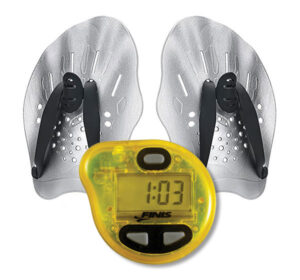 Hand Paddles – Hand paddles are a type of swim training aid used to increase the intensity of a swim workout. They are designed to fit over your hands, adding resistance to the arm stroke and helping to increase strength and power in the arms, shoulders, and core. Hand paddles can also help to improve technique and stroke efficiency by providing feedback on the swimmer’s form. With that said, if you use them be careful as you have a higher risk of shoulder injury due to the added resistance.
Hand Paddles – Hand paddles are a type of swim training aid used to increase the intensity of a swim workout. They are designed to fit over your hands, adding resistance to the arm stroke and helping to increase strength and power in the arms, shoulders, and core. Hand paddles can also help to improve technique and stroke efficiency by providing feedback on the swimmer’s form. With that said, if you use them be careful as you have a higher risk of shoulder injury due to the added resistance.
Tempo Trainer – The tempo trainer device is all about your stroke rate. It’s used in swimming to help swimmers improve their stroke technique and speed. It works by playing a beep sound at a set interval, which the swimmer needs to match with their stroke rate. Really helps you stay on tempo and maintain an efficient stroke rate. In the end if you can improve your stroke rate without shortening your stroke length, you will swim faster. I have not used this type of device yet but have heard other athletes experience some success with them.
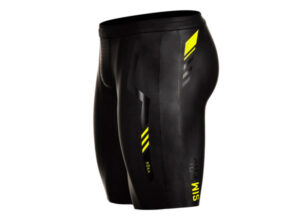 Buoyancy Shorts – Here is another piece of gear designed for keeping you afloat while allowing you to practice specific swimming techniques. They are known to develop proper form and body position in the water, as well as help with balance and stability. I will state that not all coaches have the same view. Some feel once these shorts are introduced to an athlete, they become a bit lazy and start to rely on them too much. They end up losing their kicking strength and overall body positioning. I do find value in them as they help with understanding what good body position feels like and can also be used for training days where you may be dealing with some shoulder or back pain and want to get a light swim in without aggravating the issue more. I do caution my athletes to use them sparingly.
Buoyancy Shorts – Here is another piece of gear designed for keeping you afloat while allowing you to practice specific swimming techniques. They are known to develop proper form and body position in the water, as well as help with balance and stability. I will state that not all coaches have the same view. Some feel once these shorts are introduced to an athlete, they become a bit lazy and start to rely on them too much. They end up losing their kicking strength and overall body positioning. I do find value in them as they help with understanding what good body position feels like and can also be used for training days where you may be dealing with some shoulder or back pain and want to get a light swim in without aggravating the issue more. I do caution my athletes to use them sparingly.
